Anticoccidial Drugs Market Size
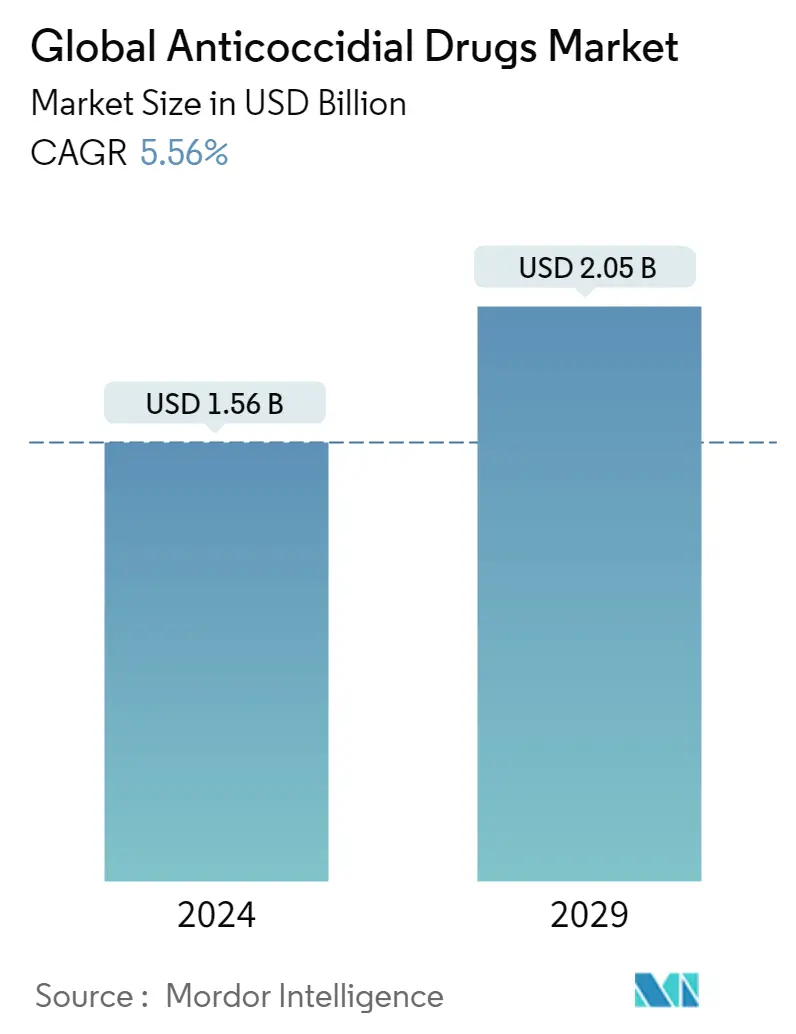
| Study Period | 2019 - 2029 |
| Market Size (2024) | USD 1.56 Billion |
| Market Size (2029) | USD 2.05 Billion |
| CAGR (2024 - 2029) | 5.56 % |
| Fastest Growing Market | Asia-Pacific |
| Largest Market | North America |
Major Players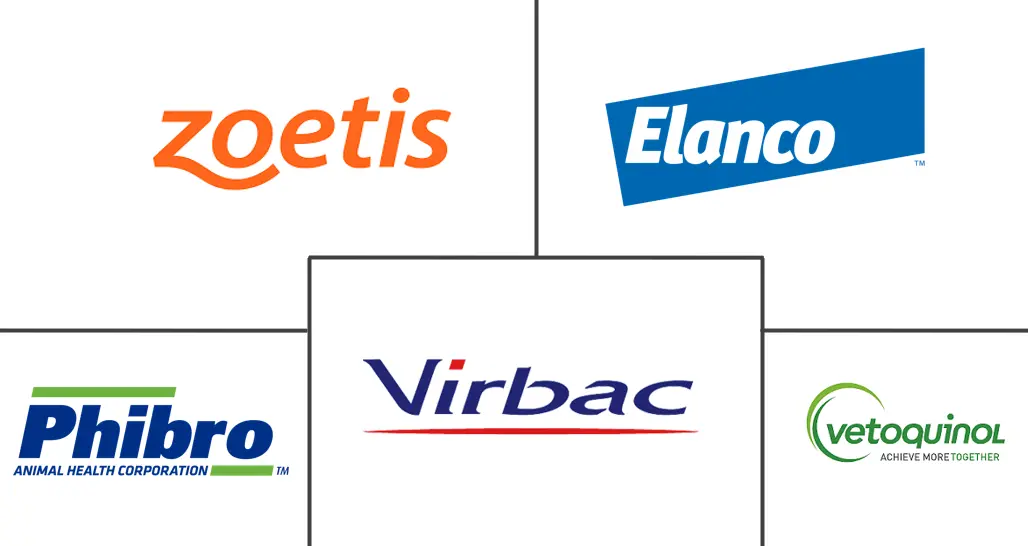
*Disclaimer: Major Players sorted in no particular order |
Anticoccidial Drugs Market Analysis
The Global Anticoccidial Drugs Market size is estimated at USD 1.56 billion in 2024, and is expected to reach USD 2.05 billion by 2029, growing at a CAGR of 5.56% during the forecast period (2024-2029).
Due to the COVID-19 outbreak, a short-term negative impact was seen on the market due to decreased visits to veterinary hospitals and clinics. Healthcare services were significantly reduced due to social distancing measures taken by governments across the globe. According to a February 2021 article published in Frontiers in Veterinary Science, dog owners also feared the COVID-19 infection and its spread, leading to fewer disease diagnoses for pets. Additionally, the study above also indicated that, like many other professions, veterinarians were significantly impacted by the onset of COVID-19 in the initial phase of the pandemic. However, the pandemic drove pet owners to email, text, and even video call veterinarians on a scale never seen before. The number of veterinarians offering digital or remote consultations increased by 20% as a result of the pandemic, with almost half of the veterinarians (47%) offering online services. This surge in interest and demand for online veterinary services is rapidly changing the pet care landscape.
A significant burden of coccidiosis in animals across the globe is expected to boost the market. Coccidiosis is one of the most severe enteric problems in the poultry industry. The most catastrophic Eimeria tenella outbreaks occurred in the early stages of intensive chicken farming. The coccidia species Eimeria tenella produces severe hemorrhages and hypovolemic shock, both of which are fatal for the infected bird. However, subclinical coccidiosis is responsible for an even greater proportion of production losses caused by damage to intestinal cells which further leads to decreased body weights, increased feed conversion rates, a lack of flock uniformity, difficulties with skin pigmentation, and, in the end, mortality.
Moreover, Eimeria is a genus of apicomplexan parasites that includes various species capable of causing the disease coccidiosis in animals such as cattle, poultry, dogs, cats, and smaller ruminants, including sheep and goats. According to a research article published in August 2022 by Anthony Andrew, nearly 20 or more Eimeria species have been identified in cattle feces worldwide. According to the article, clinical infection usually begins at 1-2 months of age because coccidiosis rarely manifests in the first three weeks of life. Thus, the burden of coccidiosis among the target animals of a specific age demands the availability of the anticoccidial drugs. As a result, market growth is expected during the analysis period.
A significant rise in the adoption of pet animals, including dogs, cats, and even horses, as companions of human beings, has been observed over recent years. Furthermore, farm animals such as cattle and swine are being taken in for a variety of commercial reasons. Because of their promising economic conditions, industrialized economies account for a disproportionately significant share of animal ownership. For instance, according to the 2022 published data by the Pet Food Manufacturers Association (United Kingdom), 17.4 million or 62% households in the United Kingdom owned pets in 2022. As the pet owners are more concerned and aware of the safety of their pets, this is likely to create demand for preventive and curative advanced therapeutic products, thereby boosting the market growth.
While these factors are expected to propel the growth of the studied market over the forecast period, the availability of alternative treatment methods in the market is anticipated to hamper the market growth.
Anticoccidial Drugs Market Trends
This section covers the major market trends shaping the Anticoccidial Drugs Market according to our research experts:
Companion Animal Segment is Anticipated to Witness Growth Over the Forecast Period
The companion animal segment in the anticoccidial drugs market is expected to hold a major market share, largely due to the increased adoption of companion animals. Besides, the advanced healthcare infrastructure in the region is also contributing to market growth.
Additionally, as per the Merck & Co., Inc. data updated in August 2022, the Isospora species is the most common cause of coccidiosis in cats and dogs. Almost every cat gets infected by Isospora felis in its lifetime. Additionally, as per the source mentioned above, coccidiosis generally occurs in young animals in facilities with a high population and potential for contamination. Thus, this disease may become a problem in breeding or boarding catteries and kennels. This burden of coccidiosis among companion animals creates opportunities for developing anticoccidial drugs, which is expected to contribute to segment growth.
Furthermore, data updated by Kingsdale Animal Hospital in January 2022 stated that coccidia is one of the most common intestinal parasites found in dogs, and the prevalence of coccidia is 50% in dogs with a variation in incidence. Thus, this shows nearly half of the dog population globally is infected with coccidiosis and is anticipated to create demand for anticoccidial drugs which is likely to contribute to the market growth.
Additionally, the adoption of companion animals is rising globally as a result of the affection between humans and animals, which is widely acknowledged as an effective way to reduce stress during a period of uncertainty and assist in easing depression and anxiety due to social isolation, which is likely to propel the segment's growth over the forecast period. As per the UK's Pet Food Manufacturers' Association's data (PFMA), there were around 34 million pets in the UK in 2022, including 12 million cats and 12 million dogs, along with 3.2 million small mammals such as guinea pigs and hamsters. The trend is further expected to grow during the forecast period, which is projected to boost the market growth.
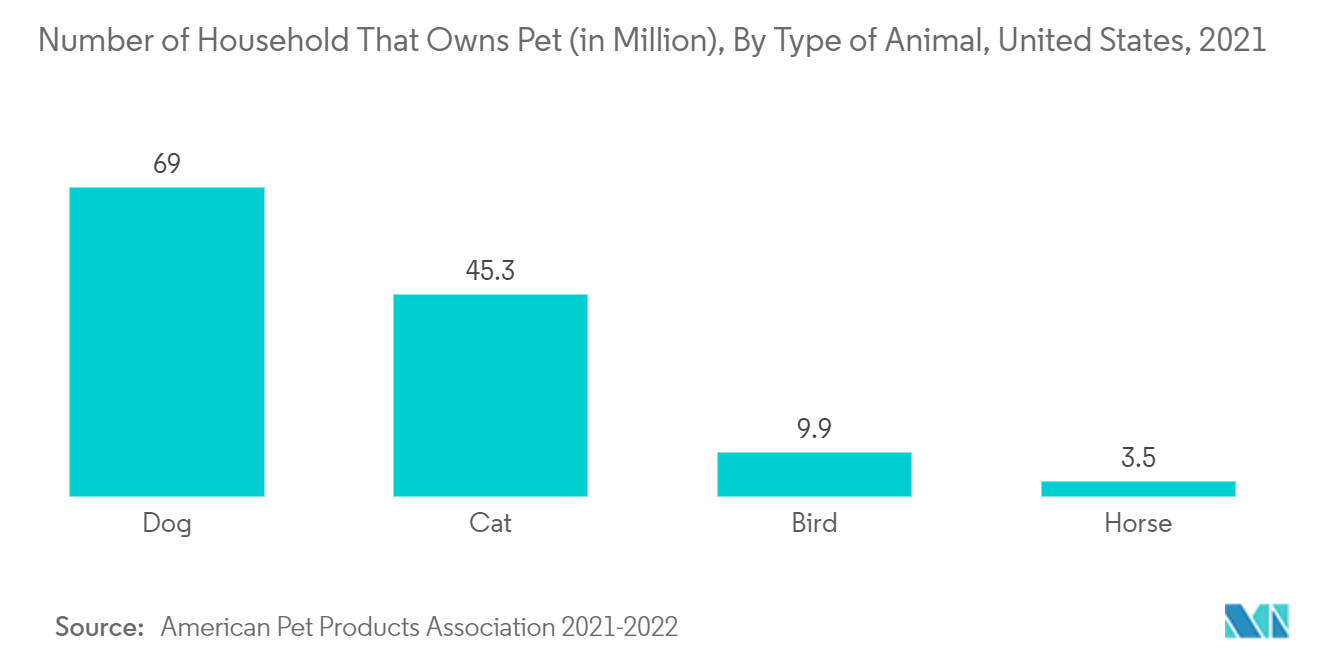
North America is the Fastest Growing Region in the Anticoccidial Drugs Market
North America currently dominates the anticoccidial drugs market and is expected to continue its stronghold for a few more years. Factors such as rising animal adoption and increasing per capita animal healthcare expenditure contribute to the region's market growth.
The increasing trend of pet adoption in the United States is predicted to propel market growth. For instance, according to the National Pet Owners Survey of 2021-2022, conducted by the American Pet Products Association (APPA), around 70% of United States households owned a pet, which equates to 90.5 million homes, including 45.3 million cats and 69 million dogs. This growing adoption of companion animals that are more prone to fungal diseases such as coccidiosis is expected to boost the demand for anticoccidial drugs over the forecast period.
In addition, companion animal or pet ownership is increasing in other countries, such as Canada and Mexico. The data published by 'Pet Keen' in May 2022 showed that nearly 38% of Canadian households owned a cat, while 35% owned a dog in 2021. Also, the source mentioned above estimated that pet owners in Canada are spending more money on their pets than before, and 17% of owners are willing to spend more than USD 500 every year for their pet healthcare. Besides, several research have shown that coccidiosis is more prevalent among pet dogs and cats and awareness about the same is also increasing among pet owners. This increasing awareness among pet parents is expected to create demand for the availability of innovative drugs thereby driving the market growth.
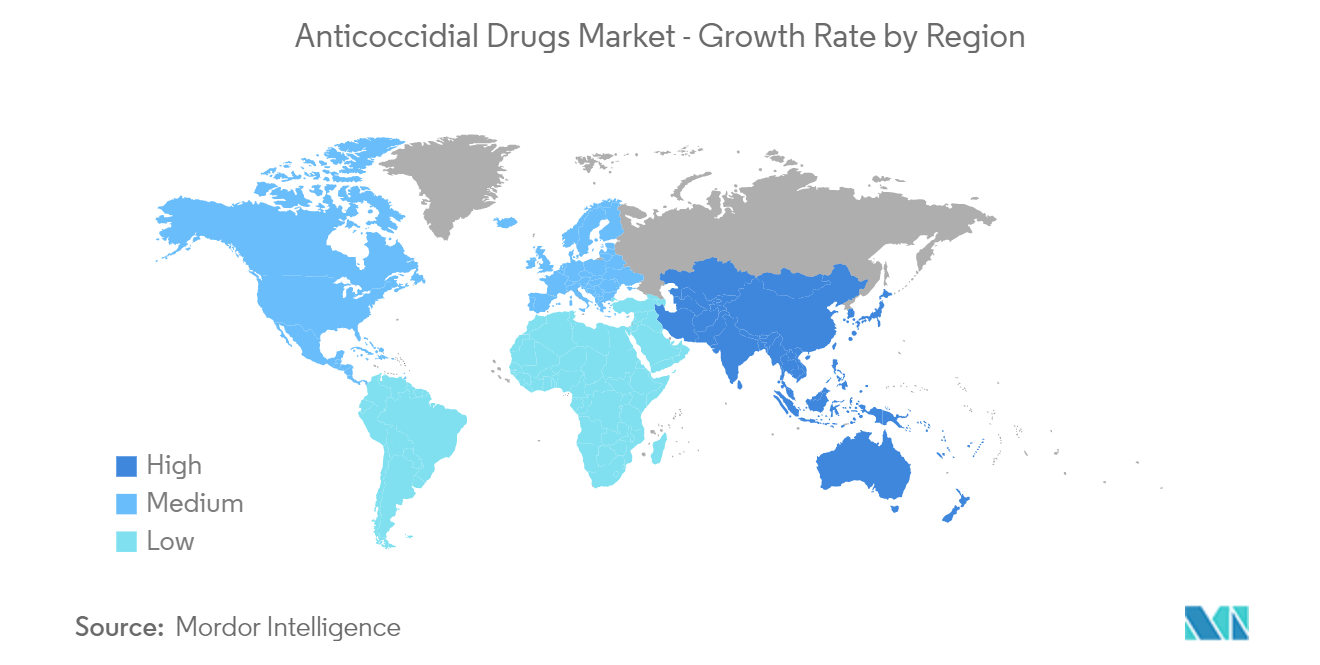
Anticoccidial Drugs Industry Overview
The anticoccidial drugs market is competitive with the presence of several players. Major market players primarily focus on continuous product development while adopting growth strategies such as mergers, acquisitions, and partnerships. Major players include Boehringer Ingelheim, Ceva, Elanco Animal Health, Merck, Virbac, and Zoetis.
Anticoccidial Drugs Market Leaders
-
Vetoquinol SA
-
Phibro Animal Health Corporation
-
Virbac
-
Elanco
-
Zoetis
*Disclaimer: Major Players sorted in no particular order
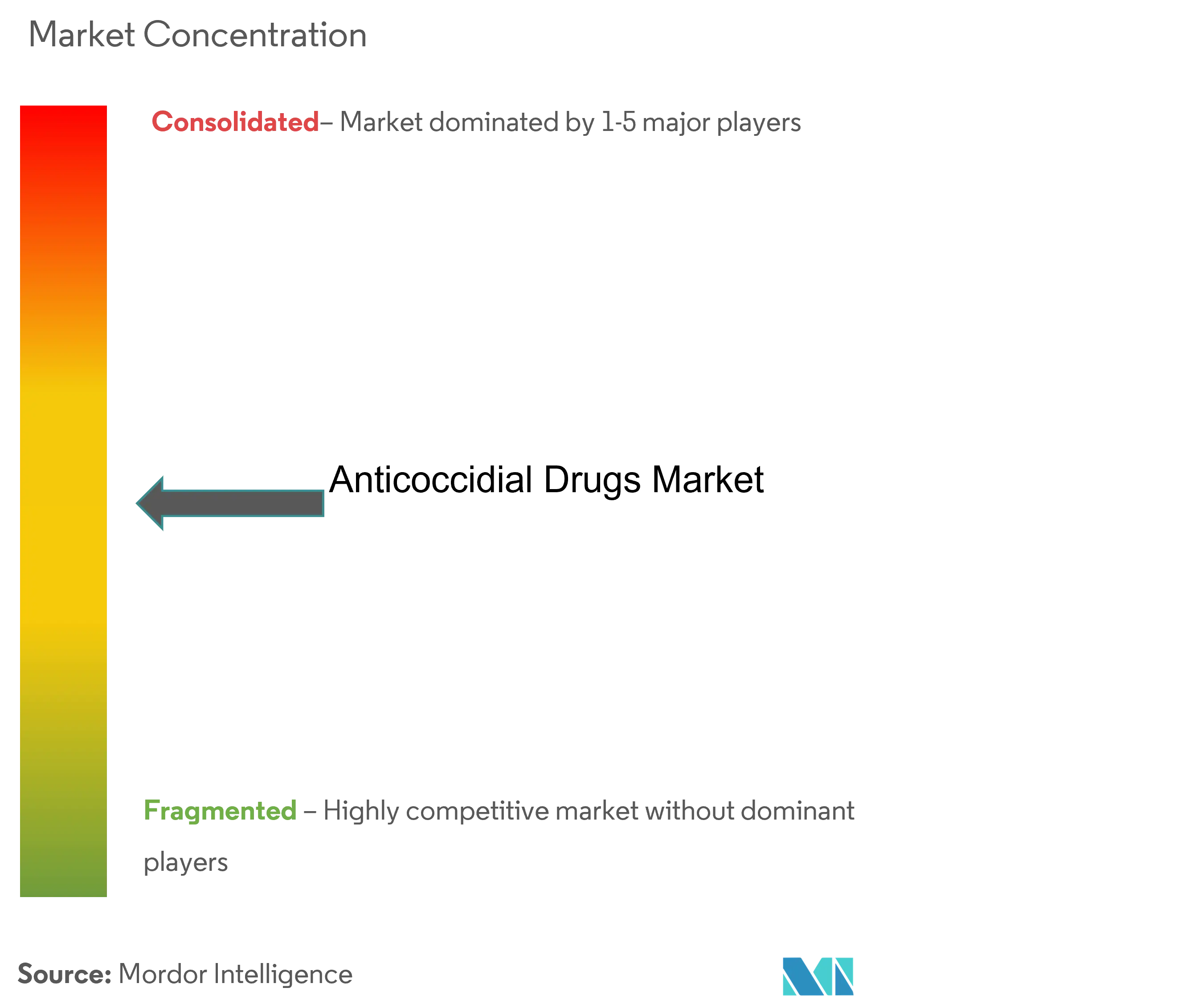
Anticoccidial Drugs Market News
- In August 2022, ZIVO Bioscience, Inc., a biotech/agtech R&D company, received a letter from the United States Department of Agriculture's (USDA) Center for Veterinary Biologics (CVB) affirming that the agency has claimed jurisdiction to review the company's novel immune-modulating biologic for treating coccidiosis in broiler chickens.
- In March 2022, Amlan International launched two new natural alternatives to antibiotics for poultry and livestock, such as Phylox Feed and NeutraPath. Phylox Feed is a natural alternative to anticoccidial drugs and vaccines that can help producers increase profitability.
Anticoccidial Drugs Market Report - Table of Contents
1. INTRODUCTION
- 1.1 Study Assumptions and Market Definition
- 1.2 Scope of the Study
2. RESEARCH METHODOLOGY
3. EXECUTIVE SUMMARY
4. MARKET DYNAMICS
- 4.1 Market Overview
-
4.2 Market Drivers
- 4.2.1 Increased Incidence of Coccidiosis Globally
- 4.2.2 Advancements in Veterinary Healthcare
-
4.3 Market Restraints
- 4.3.1 Availability of Alternative Treatment Options in the Market
-
4.4 Porter's Five Forces Analysis
- 4.4.1 Threat of New Entrants
- 4.4.2 Bargaining Power of Buyers/Consumers
- 4.4.3 Bargaining Power of Suppliers
- 4.4.4 Threat of Substitute Products
- 4.4.5 Intensity of Competitive Rivalry
5. MARKET SEGMENTATION (Market Size by Value - USD million)
-
5.1 By Drug Class
- 5.1.1 Ionophore
- 5.1.2 Antibiotic
- 5.1.3 Sulphonamides
- 5.1.4 Chemical Derivative
- 5.1.5 Other Drug Classes
-
5.2 By Drug Action
- 5.2.1 Coccidiostatic
- 5.2.2 Coccidiocidal
-
5.3 By Animal
- 5.3.1 Livestock Animals
- 5.3.1.1 Cattle
- 5.3.1.2 Poultry
- 5.3.1.3 Other Livestock Animals
- 5.3.2 Companion Animals
- 5.3.2.1 Dogs
- 5.3.2.2 Cats
- 5.3.2.3 Other Companion Animals
-
5.4 By Distribution Channel
- 5.4.1 Veterinary Hospitals
- 5.4.2 Retail Pharmacy
- 5.4.3 Other Distribution Channels
-
5.5 Geography
- 5.5.1 North America
- 5.5.1.1 United States
- 5.5.1.2 Canada
- 5.5.1.3 Mexico
- 5.5.2 Europe
- 5.5.2.1 Germany
- 5.5.2.2 United Kingdom
- 5.5.2.3 France
- 5.5.2.4 Italy
- 5.5.2.5 Spain
- 5.5.2.6 Rest of Europe
- 5.5.3 Asia-Pacific
- 5.5.3.1 China
- 5.5.3.2 Japan
- 5.5.3.3 India
- 5.5.3.4 Australia
- 5.5.3.5 South Korea
- 5.5.3.6 Rest of Asia-Pacific
- 5.5.4 Middle East & Africa
- 5.5.4.1 GCC
- 5.5.4.2 South Africa
- 5.5.4.3 Rest of Middle East and Africa
- 5.5.5 South America
- 5.5.5.1 Brazil
- 5.5.5.2 Argentina
- 5.5.5.3 Rest of South America
6. COMPETITIVE LANDSCAPE
-
6.1 Company Profiles
- 6.1.1 Zoetis
- 6.1.2 Phibro Animal Health Corporation
- 6.1.3 Huvepharma
- 6.1.4 Elanco
- 6.1.5 Biochem Pharma
- 6.1.6 Ceva
- 6.1.7 Impextraco NV
- 6.1.8 Virbac
- 6.1.9 Boehringer Ingelheim International GmbH
- 6.1.10 MSD Animal Health
- 6.1.11 Vetoquinol SA
- 6.1.12 HIPRA
- *List Not Exhaustive
7. MARKET OPPORTUNITIES AND FUTURE TRENDS
** Subject To AvailablityAnticoccidial Drugs Industry Segmentation
As per the scope of the report, coccidiosis is one of the most frequent and prevalent parasitic diseases among animals. Its symptoms include weight loss, mild intermittent to severe diarrhea, feces containing mucus or blood, dehydration, and decreased breeding. Any drug used to combat the progression of coccidiosis in birds or animals, both food-producing and non-food producing, is termed an anticoccidial drug.
The Anticoccidial Drugs Market is segmented by Drug Type (Ionophore, Antibiotic, Sulphonamides, Chemical Derivative, and Others), Drug Action (Coccidiostatic and Coccidiocidal), Animal (Livestock Animals, and Companion Animals), Distribution Channel (Veterinary Hospitals, Retail Pharmacy, and Others), and Geography (North America, Europe, Asia-Pacific, Middle East and Africa, and South America). The market report also covers the estimated market sizes and trends for 17 countries across major regions globally. The report offers the value (in USD million) for the above segments.
| By Drug Class | Ionophore | |
| Antibiotic | ||
| Sulphonamides | ||
| Chemical Derivative | ||
| Other Drug Classes | ||
| By Drug Action | Coccidiostatic | |
| Coccidiocidal | ||
| By Animal | Livestock Animals | Cattle |
| Poultry | ||
| Other Livestock Animals | ||
| By Animal | Companion Animals | Dogs |
| Cats | ||
| Other Companion Animals | ||
| By Distribution Channel | Veterinary Hospitals | |
| Retail Pharmacy | ||
| Other Distribution Channels | ||
| Geography | North America | United States |
| Canada | ||
| Mexico | ||
| Geography | Europe | Germany |
| United Kingdom | ||
| France | ||
| Italy | ||
| Spain | ||
| Rest of Europe | ||
| Geography | Asia-Pacific | China |
| Japan | ||
| India | ||
| Australia | ||
| South Korea | ||
| Rest of Asia-Pacific | ||
| Geography | Middle East & Africa | GCC |
| South Africa | ||
| Rest of Middle East and Africa | ||
| Geography | South America | Brazil |
| Argentina | ||
| Rest of South America |
Anticoccidial Drugs Market Research FAQs
How big is the Global Anticoccidial Drugs Market?
The Global Anticoccidial Drugs Market size is expected to reach USD 1.56 billion in 2024 and grow at a CAGR of 5.56% to reach USD 2.05 billion by 2029.
What is the current Global Anticoccidial Drugs Market size?
In 2024, the Global Anticoccidial Drugs Market size is expected to reach USD 1.56 billion.
Who are the key players in Global Anticoccidial Drugs Market?
Vetoquinol SA, Phibro Animal Health Corporation, Virbac, Elanco and Zoetis are the major companies operating in the Global Anticoccidial Drugs Market.
Which is the fastest growing region in Global Anticoccidial Drugs Market?
Asia-Pacific is estimated to grow at the highest CAGR over the forecast period (2024-2029).
Which region has the biggest share in Global Anticoccidial Drugs Market?
In 2024, the North America accounts for the largest market share in Global Anticoccidial Drugs Market.
What years does this Global Anticoccidial Drugs Market cover, and what was the market size in 2023?
In 2023, the Global Anticoccidial Drugs Market size was estimated at USD 1.48 billion. The report covers the Global Anticoccidial Drugs Market historical market size for years: 2019, 2020, 2021, 2022 and 2023. The report also forecasts the Global Anticoccidial Drugs Market size for years: 2024, 2025, 2026, 2027, 2028 and 2029.
Anticoccidial Drugs Industry Report
Statistics for the 2024 Anticoccidial Drugs market share, size and revenue growth rate, created by Mordor Intelligence™ Industry Reports. Anticoccidial Drugs analysis includes a market forecast outlook 2029 and historical overview. Get a sample of this industry analysis as a free report PDF download.



